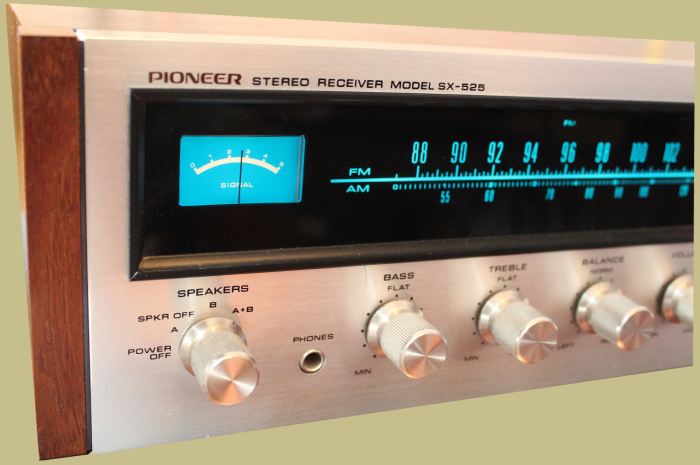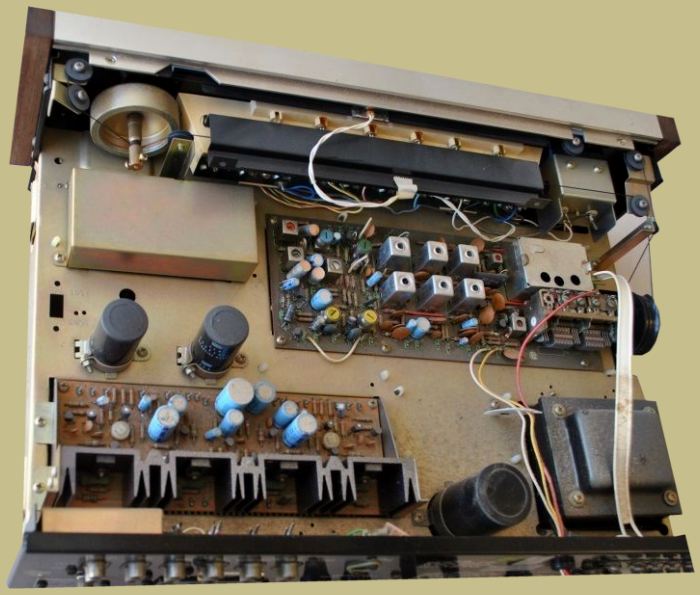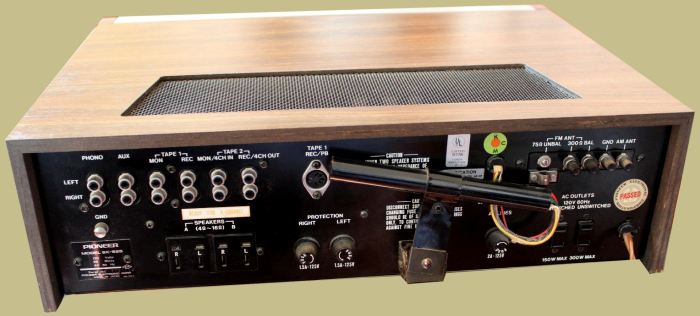
In 1972 Pioneer introduced the SX-525 and continued production up until around 1974. The SX-525 is a low to medium powered receiver designed for those on a budget. Pioneer’s advertising language at the time stated:
Stereo on a budget can have a lot of the power and a lot of the frills of very expensive stereo, as this superlative new AM/FM receiver from Pioneer so amply proves.

The Pioneer SX-525 retailed for about $240.00 and featured the silver face plate and black dial face styling early 70’s Pioneer receivers. The blue backlit dial and signal meter, as well as the red dial indicator, make this a very appealing receiver in the dark.

It is a relatively modest power producer putting out 17 watts per channel. Still, this is plenty for most users. It features a sensitive FM tuning section along with an FM muting switch. Inside is all solid state and the circuitry incorporates FET transistors.

There are hookups for a turntable, 2 tape decks and two sets of speakers. There is also an AUX connection. Note also that the SX-525 utilizes the somewhat hard to find speaker plugs. These can be found occasionally on eBay. You can find what’s currently available HERE.


Overall the Pioneer SX-525 is a great little receiver if you just want to fill a small to medium sized room or garage with music. It has the basic features you’ll need and sufficient power output to run most speakers. While not highly sought after by collectors they are desired by users wanting to try a vintage audio sound without breaking their budget.


Hello , I’m getting into the vintage receiver road , I may purchase a pioneer SX 525 but the 17 watts is not enough for me . Would I be able to connect an external to it ?
Thanks
This is going to be kind of satirical, but the truth. Inflation has struck watts. I just recently got into vintage receivers. I have a modern JVC home theater type receiver, bought for surround sound movies, and it got retired to my play room building. supposed to put out a 100 watts per channel. It gets very loud in my 20×20 block building playroom. I just bought a Pioneer SX-780, rated at about 45 or 50 watts. The Pioneer blows the JVC out of the water! I can barely get the volume up to 3/4 and the windows start to shake! My speakers are Seeburg Laser CD speakers, heavy as heck, about 3 ft tall with 12 inch woofer, a horn and midrange, Not even sure what their wattage is, can’t seem to locate a model number for them(have not looked too hard), but they were designed for adding to jukeboxes. 50 watts back in the 70s is like 100 watts today, inflation!
The 525, like most receivers, lacks preamp outputs,
so connecting an external power amplifier is almost impossible.
An audio repair shop could add a stereo cable with RCA jacks for that purpose,
but there isn’t a good opening in this model for the installation of such a cable.
>> You must NEVER drill holes in a vintage component for Any reason,
and don’t remove or modify the DIN connection, which is specifically intended for use with tape decks.
I own a 525 and I did replace the speaker jacks with pushbutton terminals,
but that did not require any drilling or other modifications.
The procedure I performed is entirely reversible and would leave no evidence of having been done.
If you want more power, the best thing to do is get a receiver that can deliver it to start with.
All that said, there is something that would work, though it isn’t recommended:
Get two 10,000 ohm (10k) resistors and two 100 ohm resistors.
They can be small (1/4 watt or 1/2 watt) since they won’t be called upon to dissipate any real power.
Connect one end of one 10k resistor to the + speaker terminal of one channel.
Connect the other end of that resistor to one end of a 100 ohm resistor.
Connect the remaining end of the 100 ohm resistor to the speaker – terminal.
Connect the junction of the resistors to the center conductor of a patch cable.
Connect the screen (shield) of the cable to the speaker – terminal.
Repeat all of that for the other channel.
Connect the other ends of the cables to the inputs of a power amplifier.
Remember — this is Not an ideal way to derive a usable signal, just one that will do the job.
REC OUT is the preamp out as it will send a line level signal to an amp.
But if you want an amp to shine….
Power amps can handle speaker level outs. So, in reality it does have a powered preamp out via the speaker line outputs.
I run a Pioneer 313 as my preamp via speaker line out to a Rockville 3000 watt amp.
I run it all day and night most of the time at 75% max power.
Most amps will handle the speaker line out to input without a problem at all.
I have the old Pioneer sx-525 receiver. Love it. The old speakers are damaged. Which speakers should I buy? Thank you!